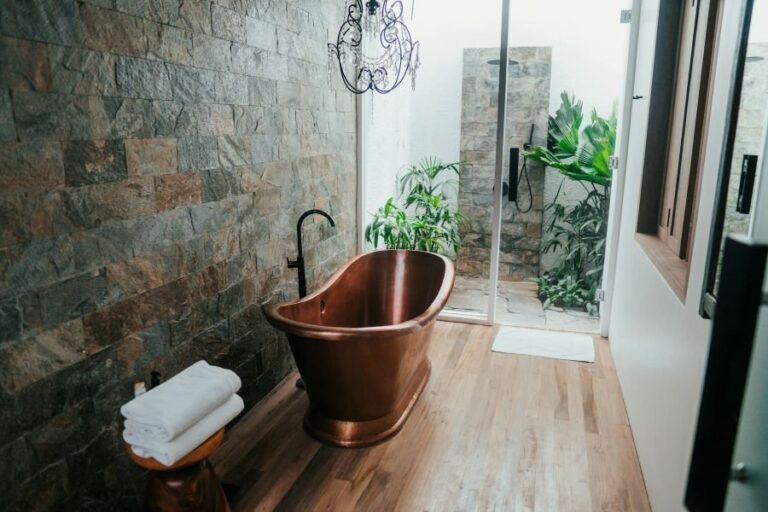Engineered wood
If you love the look of wood but don’t have the budget for floorboards, then engineered wood could be the answer. Engineered wood flooring is typically available in large or small planks, so you can lay it to look like traditional floorboards or in a herringbone or parquet style for extra impact.
The planks are often made from plywood with an oak top layer, so you can still enjoy the natural graining of wood on your floor. Engineered wood planks usually come with a lacquer or oil finish, so there’s no need to seal them. However, if you want your engineered wood floor to be durable, choose planks that have a deep top layer. So, they can be sanded down in the future to remove nicks and scratches.
Engineered wood flooring commonly uses tongue and groove joints and needs to be glued or nailed down. So, you’re best getting it fitted by professionals.
LVT
Luxury vinyl tiles are an equally effective and affordable alternative to wooden floorboards. They’re scratch and moisture-resistant and easy to clean but can’t be refinished as engineered wood can.
However, you can lay LVT to look like traditional floorboards or parquet flooring. And as vinyl planks and tiles are easy to cut, this flooring is much easier to work with. So, you can get creative and add borders and motifs to your floor.
Some planks are designed to click together as a floating floor while others are designed to be glued down. The benefit of glue-down vinyl is that you don’t need to worry about leaving expansion gaps. This means you can get a neater finish but expansion gaps can easily be hidden with decorative trim.
Installing vinyl flooring is fairly straightforward. However, it does require a smooth, level surface underneath. So again, you may be wise to have it professionally installed.
Laminate
Laminate flooring has had a bit of a bad reputation in the past. But there’s a lot of plus points to using it instead of solid wood flooring. Firstly, it’s a much more affordable option. Secondly, most products simply click together as floating flooring, so there’s no need for glue or nails. This makes them easy to install. So, with the right tools and skills, you may be able to fit laminate flooring yourself.
With laminate flooring, it’s best to see a sample first, so you can be sure of its quality. To get a good finish, you want it to have a realistic wood grain. So, go for a wider pattern and plank size. This should also speed up fitting. Also, look for the type with bevelled edges or V-shaped grooves, to ensure they look like real floorboards.
Tiles
One option you might not have considered instead of wooden floorboards is tiling. However, there are plenty of brands that produce plank-shaped tiles with a realistic wood texture and pattern.
The big advantage here is that tiles are very easy to clean and are of course, incredibly durable. So, you may find this an attractive option if you have a busy family home. They can also cope in moist environments and won’t absorb water splashes, making them ideal for bathrooms and kitchens.
The only thing you need to consider is the grout. Standard white grout will stand out, potentially ruining the wooden floorboard effect. Ideally, try to match the grout colour to the tile or go with a darker shade such as brown, grey or black to ensure it blends in.
Bamboo
Although it’s not technically wood, bamboo still provides a nice, grained pattern and has a natural, wood-like hue. So, it can look very similar to hardwood floorboards. And like hardwood, it’s very tough and as with other similar materials, it doesn’t harbour dust and pollen in the way that carpet can. This makes it a good option for hallways and bedrooms. However, despite being moisture-resistant, it’s not as well-suited to bathrooms and kitchens as tiles.
Bamboo costs around the same as engineered wood and can also be laid as planks or parquet. It’s considered more sustainable than wood flooring but it’s wise to check you’re buying a product that doesn’t contain high levels of VOCs and get it professionally installed for a good finish.
Cork
Unlike wood flooring, cork is made from the bark of trees. This means it doesn’t have the same type of graining. However, it does have a unique and woody, patterned surface. So, you won’t be short on texture and warm tones.
Modern cork tiles can also be laid in a parquet style and some brands offer colour variations, so you do have some choice. However, you may find there are more options available with laminate, LVT and engineered wood.
Like bamboo, cork is a more sustainable option for flooring. But it has other advantages too. Cork has a softer feel underfoot and provides a bit more warmth and cushioning than standard floorboards. So, it’s a popular choice for family homes. If you want to keep the installation simple, look for cork flooring that comes ready-sealed and has integrated underlay.



